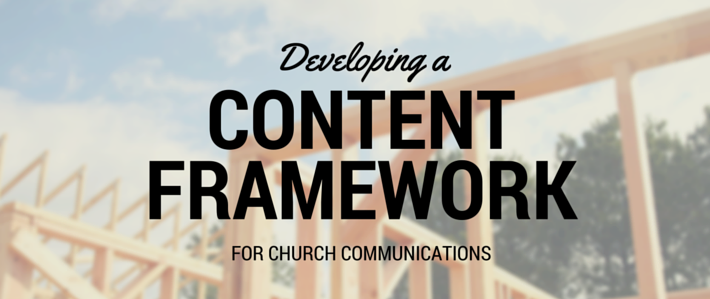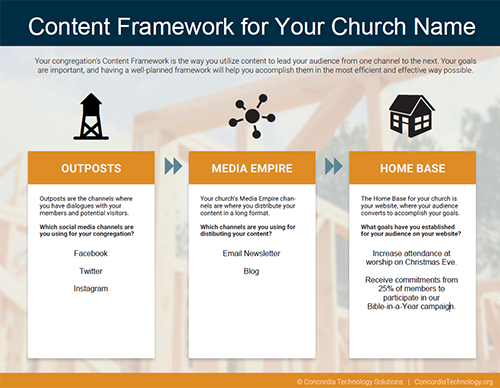
The meaning of the word “content” has evolved over the last few years. It used to mean something that was contained, like the contents of a jar, or the chapters of a book. Now, content has the broader definition of being “a substance of significance.”
In the digital world, content is not only words (like this blog), but also images and videos. In fact, even something as abstract as an idea can be considered content.
The value of content is not defined by its container, but rather by its quality. True content can have many different containers, and the implementation and purpose of the content can change with each container.
Think about it how this idea of content is used in the church. When a pastor prepares a sermon and finds the perfect anecdote to describe his point, he’ll probably include that story in his sermon. He may also choose to include a simpler version in his children’s message, and a longer, more detailed version in the adult Bible study. He may even use it in the church newsletter or the next time he’s asked to give a devotion.
Some might call this recycling. While that can have a negative connotation (seen as being lazy), when done well, it can actually provide a lot of value. Utilizing the same content to accomplish a specific purpose for a specific audience can make your message more efficient and effective.
So how do church communicators utilize content well? Allow me to introduce you to the idea of developing a framework for your content.
Content Framework
Chris Brogan, CEO of Owner Media Group, was the keynote speaker at the 2015 State of Digital Media Marketing Conference at the University of Missouri-St. Louis this past April. His presentation that afternoon focused on the role of content in engaging customers. He was presenting for a crowd of marketers, so not everything he said can be applied in the church, but one thing he described can (and should) be utilized by those who work in church communications.
Many marketers want to discover the new silver bullet of marketing (“How can Periscope help us grow?”). According to Brogan, utilizing different channels (including Facebook and Twitter) provides little value apart from content, and content alone is not helpful without having a plan for how to use it.
He then described the benefits of forming a “content framework,” the idea of utilizing your content to lead your audience from one channel to the next. (This was not a new concept for Brogan; he's been talking about it for more than six years). Rather than relying on one channel to generate results, a content framework assigns a role, and therefore a specific purpose, to each channel.
There are three different roles channels can play in a good content framework: Outposts, Media Empire, and Home Base.
 Outposts
Outposts
Chris defines Outposts as “those social sites where you might consider maintaining an online presence.” Think of Outposts as the channels where you can have dialogues with your audience (the social part of social media). Facebook, Twitter, and Instagram are all great places for your church to have an active presence.
This two-way communication is essential because it allows you to 1) gain a better understanding of your audience, 2) find out what content is most interesting to them, and 3) build the credibility to suggest your content as valuable to your audience.
In addition to conversations, your Outposts are where you begin to share your content in a short format that is easily and quickly digested.
 Media Empire
Media Empire
If social media is your two-way communication, then one-way communication channels are the home of your church’s Media Empire. The most common type of channels in a Media Empire are blogs and email newsletters.
These channels distribute your content in a longer format than on social media. While your Outposts present a preview of your content, your Media Empire gives the entirety of it. This content can be pushed out to your audience on an opt-in basis, meaning individuals provide you with their email addresses or subscribe to your blog.
 Home Base
Home Base
Your Home Base is the place where you ultimately want your audience to go: your website. It’s the place where you set up conversion opportunities to accomplish your goals for your audience. Here, you’ll move the communication offline and begin having personal conversations.
Outposts and Media Empires are great tools, but getting people to them should not be your priority. Your purpose as a communicator is to accomplish your goals, and while you have opportunities to do that within those channels, your best opportunity to do that is on your website.
Using a Content Framework in Your Church
So now that you have understanding of what a Content Framework is, how do you go about using it? While simple in concept, a Content Framework can be somewhat difficult to implement. Why? Because you have to start at the end!
1. Define Your End Goals
What do you want your audience to do? What specific actions do you want your audience to take? Goals should be simple like “Increase attendance at worship on Christmas Eve” or “Receive commitments from 25% of members to participate in our Bible-in-a-Year campaign.”
This is a very important step, but I will caution you to not overthink it too much. Remember, while your ultimate goal is for people to be saved by grace through faith, leave that part to the Holy Spirit and focus on the things you can do to support it.
2. Establish Conversions to Support Goals
Once your goal is defined, think of the action your audience needs to take immediately before that. Is it to attend Christmas Eve worship service? Ask them to RSVP (and give them a calendar event to download so they get a reminder). Is it to participate in your Bible reading program? Give them a downloadable schedule of the readings.
Your conversions should accomplish two things: getting your audience as close to completing the goal as possible, and providing you with the information you need to know if you were successful in accomplishing your goals. Dedicated pages on your website (Home Base) with simple forms work great for most conversions.
3. Create Content that Encourages the Conversions
When your goals are as simple as the two ideas listed above, it’s actually pretty easy to provide the supporting content. What information will make it easier for your audience to commit to the next action?
For the Christmas Eve service, provide an overview of what will happen, like a sample of some of the songs that will be sung, or whether the Lord’s Supper will be served. For the Bible reading program, tell them more about the time expectations and if there is any accountability. An email or a blog post (Media Empire) with this information should provide just the right amount of detail.
4. Peak Your Audience’s Interest in Your Content
Once your content is available through your Media Empire channels, use your Outposts to draw traffic to it. Share snippets of the most interesting content to encourage clicks, and use different formats to engage your audience. Consider a short video of last year’s Christmas Eve service or maybe a small screenshot of the Bible reading plan schedule. These interactions should be like a conversation, so don’t leave it at just one post or tweet, but stay engaged with your audience continually.
Don’t Go in Reverse
Make sure you’re always sending people in the first direction. Social media is fun, blog posts are engaging, and websites are often not that exciting. I understand the temptation, and it is very easy to fall into it without thinking, but be sure to not send your audience in reverse.
I know you’ve spent a lot of time building up your social media following, but don’t send your blog readers back to your Facebook page. That’s a step backward, and one step further away from your goal! And I know that blog post took you a lot of time to write, but when someone is about to submit a form on your website, avoid distracting them with a link to your blog.
Your goals are important. A well-planned content framework will help you accomplish those goals in the most efficient and effective way possible!
Ready to set up a Content Framework at your church?
Download our free template to get started.
























